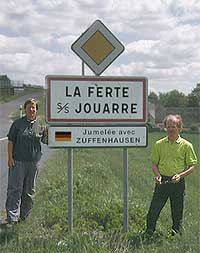Mills in Alto Aragón
La Ferté-sous-Jouarre
La Ferté-sous-Jouarre was once known for the world's best mill stones.
You'll find this in almost any text about the subject. Some writers tell us it's
located in the region of Paris (France); they disagree about the exact distance, however.
And only one thoroughbred ever bothered to dig into the industrious past of the city.
When we wondered what was preserved from those glorious days
and tried to find answers, we couldn't find any reference. The city's website
kept silent about mills (
‡). There was a camp-site, yes, and a hotel or two. And if there was a museum it was not about stones. We browsed several guidebooks. Not a word.
So we decided to study the matter on the spot and set out to visit
La Ferté-sous-Jouarre with camera and plenty of film.
Pictures: 02.V.2003
(1) Our investigative team
at La Ferté's city border |
(2) City map can help you
in tracing remnants
of an important industry. |
When you enter the city you will
probably notice the presence of a mill stone on some roundabout, but in
general nothing reminds you of the past activities.
Although a rapid decline set in after the
Great War of 1914 two companies managed to survive into the 1950's.
Not the least effort, however, was put into preserving buildings or other artefacts
to keep the memories alive. You really need a magnifying glass to pick
the last cherries out.
Try to find the Guide de découverte du patrimoine meulier. It is a leaflet
with two maps indicating things interesting from the mill stone time. Do not trust
it entirely however. We dashed for hours up and down the Bois de la Barre looking
for an educational trail that was still en projet as we learned later on.
Other things are simply not there anymore and fallen of the roof (like a weathervane)
or replaced by a shopping center. But nevertheless, the Guide will be of great help.

(3) La Ferté-sous-Jouarre
The quarries were small and exploitation
changed very often. An exploitation was started, the good stones were removed and
after that the site was abandoned for a better spot. During the peak period several
hunderds of quarries were scattered over the hills surrounding La Ferté.
The panorama from left to right
shows some of the main sites: Bois de la Barre, La Justice, Le Limon, then
the neighborhood with the railway station and finally La Marne. On the left (southern)
bank we have La Marne with the mill stone port and the hill with the Tarterel quarries.
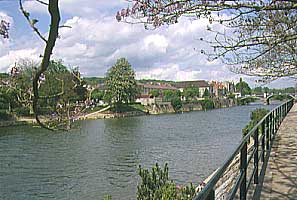
(4) La Marne from Quai des Anglais
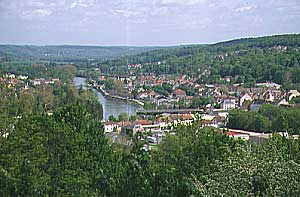
(5) Left bank with Port aux meules
Water was a permanent sore
and quarries closed down were soon flooded. Trees had ample time to grow since the
shutdown of the business. The Bois de la Barre hides several nice examples.
Read Les Meuliers for an account on the history, types
of mill stones, the quarries, the horrendous conditions and the health problems of the people.
We will here only focus on what's important for our study
about Aragón's mills. Read also Los Molinos del Altoaragón.
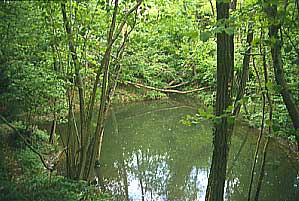
(6) Flooded quarry - Bois de la Barre
Early mill stones from La Ferté were monolithes.
It's only because of new developments in milling technology (the advent of
cilinders), difficulties in finding stones big enough and higher requirements
in meal quality that the companies were pressed to manufacture composite stones
and change the ridge pattern. But the industry remained very conservative and they
missed many chances to improve the health conditions, production methods and the profitability of
their business.
In Aragón and before arrival of the train millers were limited
to local stones. After that (it happened at the end of the 19th century) several
forces were at work.
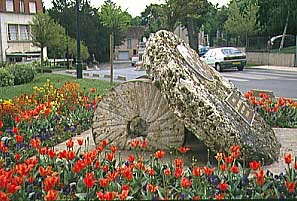
(7) older monolith and more recent kind
The railway made it possible to transport the better
French stones from La Ferté into the region, giving millers the option
to fit out their business with better equipment. Not all were up to it. The
more profitable mills modernized first. Some regions were never served by the
train (e.g. Sobrarbe still is not connected by railroad) and millers there were doomed
to stick with the local mill stones for a much longer time.
That same railway, and better roads, made it
possible to carry the corn down to newly built industrial mills and the flour and bread
back up to the mountain villages. It meant the end of many village mills. The better
connected to the outside world, the earlier they went. Mills in remote parts
of Altoaragón kept their function much longer and they aren't desintegrated yet.
That's also the reason why most visits to the mills start with a healthy walk.
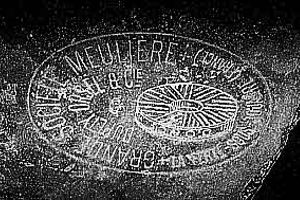
(8) Seal of G.S.M. on millstone from Alquézar
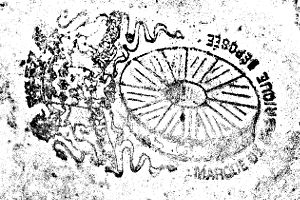
(9) Seal of S.G.M. on stone found in Paternoy.
Only a couple of companies lived
well into the 20th century. One of them was the
Grande Société
Meulière Dupety Orsel et Cie, established years earlier —its precursor dates from 1789—, but working under this name only after 1911. The company was the last one to survive: business shut down in 1957.
Stones with the logo of the G.S.M. can be found in the mills of e.g. Alquézar and Broto.
The main competitor of G.S.M. was established in 1881 between 7 founding
members. The name chosen was
Société Générale Meulière S.A., in short S.G.M. —likely purposely meant to be confusing. The company stopped working in 1953.
Stones of S.G.M.'s make were found in e.g. Paternoy (Jacetania) and Las Almunias de Rodellar.
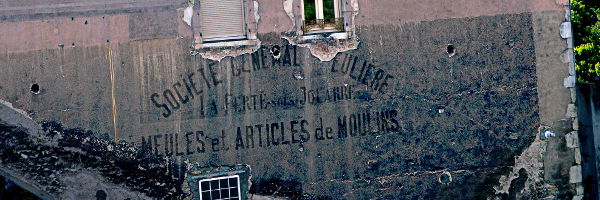
(10) Painted advertisement for S.G.M. — Gannat (03 France), 11.V.2015; pict. J. Helmons
Like to know a secret of the trade ?
Several companies ran excavations on places sometimes
wide apart (e.g. in La Ferté; in Epernon, Eure-et-Loir, near Chartres; in Cénac, Dordogne),
but almost always marked the stones La Ferté regardless of the true origin.
Publicity was made along the roads, but close to none of the painted
murals did survive. Our find of Gannat (10) is in very bad shape. The bottom half
is best preserved. The top half is obscured by newer advertisements. If you look
closely, two dark dishes can be discerned: millstones most likely (see
detail picture)
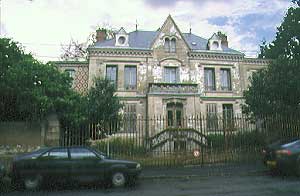
(11) House built for the founder of Dupety company
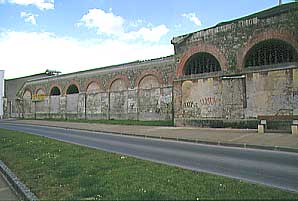
(12) Dupety's installations
The number one attraction in La Ferté is
Le port aux meules. It is the quay from where the barges
were loaded with mill stones. It is built from large monolithes.
Later, when the train reached La Ferté, the quay became less important and
businesses concentrated near the new railway station at the other side of the river.
Nearby you'll find what remains of the old Dupety buildings.
Originally the arcades were open. The workers did their job in the open.
There was only a break when the weather went Siberia, but then there was no pay.
The arcades of the Compagnie
du Bois de la Barre are situated in that neigborhood. They are converted into car-boxes en houses.
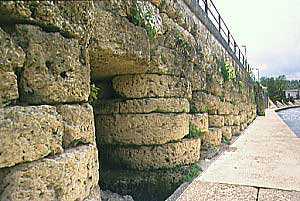
(13) Port aux meules - the millstone quay

(14) Installations of Compagnie du Bois de la Barre
| |
† |
Bongini, Joël (Ed.) — 2002 —
Les Meuliers - Meules et pierres meulières
Editions Presses du Village — 77139 Étrépilly (France)
ISBN: 2-914700-06-7; 278 pp. |
| |
‡ |
The situation slowly improved over the years: the educational trail materialized and an
important private collection was acquired. |


